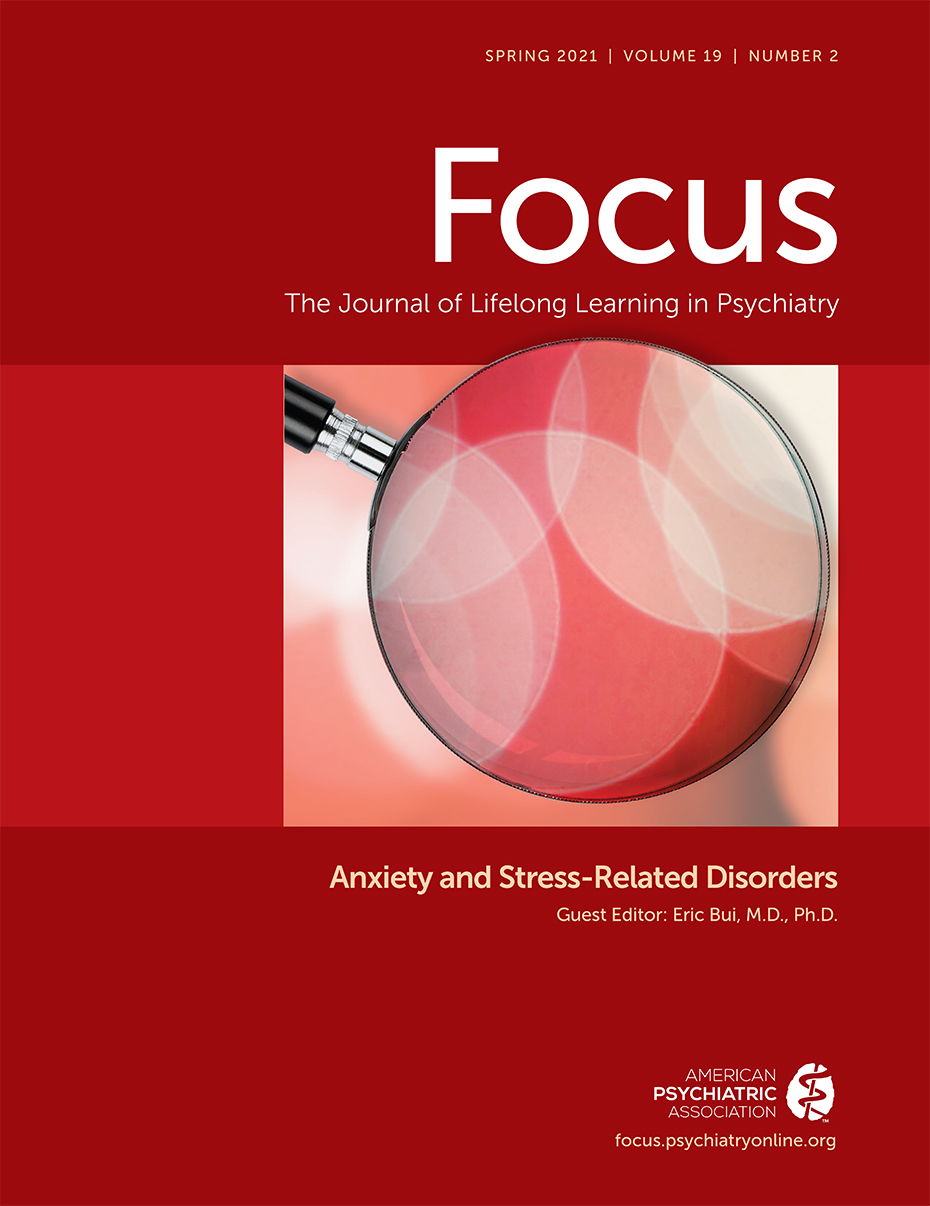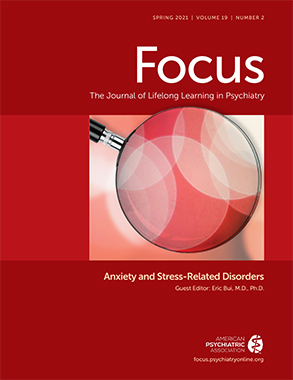Anxiety and Stress-Related Disorders—Spring 2021
Begin date April 1, 2021; End date December 31, 2022
Continuing Medical Education Information
Focus, APA’s clinical review journal, is designed as a personal study resource to help practicing psychiatrists keep abreast of significant advances in the field, with particular attention to clinical practice. The goals of Focus are to disseminate up-to-date information, facilitate lifelong learning study skills, support certification, and provide opportunity for self-assessment in order to improve patient care. Each issue, prepared by distinguished faculty who are recognized leaders in their fields, incorporates a CME component. The material can be used effectively by establishing a regular schedule of study.
In order to earn CME credit, subscribers should read through the material presented in the issue. After reading the material, complete the CME quiz (a minimum passing score of 60% is required) and submit your evaluation and study hours online in the APA Learning Center (education.psychiatry.org) (up to 5 AMA PRA Category 1 creditsTM).
Objectives
This issue of Focus provides clinicians with an overview of state-of-the-art treatment approaches for anxiety and stress-related conditions including cognitive behavioral treatments and pharmacological treatments for anxiety disorders.
As a result of this CME activity, participants will be able to
•
outline approaches to cognitive-behavioral and pharmacological treatment for anxiety disorders
•
describe prolonged grief disorder, which will be included in a DSM-5 revision
•
describe the evidence base for mind-body programs in treatment of anxiety and stress-related disorders
•
outline cross-cultural approaches to traumatic stress
•
describe how cutting-edge psychological research (network science) and pharmacological research (psychedelics) could be leveraged in the future for anxiety and stress-related conditions
Target Audience
This program is one element of a lifelong learning program for psychiatrists and other clinicians.
Disclosure of Program Planners and Authors
Author disclosures are provided with each article and online at the start of the quiz. Planner disclosures appear at the front of this issue.
Accreditation and Designation Information
The American Psychiatric Association (APA) is accredited by the Accreditation Council for Continuing Medical Education to provide continuing medical education for physicians. APA designates this journal-based CME activity for a maximum of 5 AMA PRA Category 1 credits™. Physicians should claim only the credit commensurate with the extent of their participation in the activity.
Claiming Issue Quiz Credit
Subscribers to Focus can claim CME credit by completing issue quizzes online through the American Psychiatric Association’s online education portal, APA Learning Center. To access the quizzes, readers should go to education. psychiatry.org and log in to their APA Learning Center Account. Focus issue quizzes by year can be found by selecting the Journal Subscriptions tab and choosing from the dropdown options. For assistance with online access call (800) 368-5777 or e-mail
[email protected].
1. Which of the following is a limitation of treating anxiety disorders with tricyclic antidepressants?
A.
Lack of demonstrated efficacy for social anxiety disorder
B.
High toxicity in overdose
C.
Side effects may preclude titrating to effective doses.
See “Conclusions and Future Directions” section in the article by Melaragno, “Pharmacotherapy for Anxiety Disorders: From First-Line Options to Treatment Resistance”
2. Which of the following medication treatments does NOT have demonstrated efficacy as a monotherapy in generalized anxiety disorder?
See “Review of Specific Agents and Their Efficacy and Tolerability in Treatment of Generalized Anxiety Disorder” section in the article by Melaragno, “Pharmacotherapy for Anxiety Disorders: From First-Line Options to Treatment Resistance”
3. Which of the following benzodiazepines does not depend on CYP450-mediated hepatic metabolism nor have accumulation of active metabolites?
See “Review of Specific Agents and Their Efficacy and Tolerability in Treatment of Panic Disorder” section in the article by Melaragno, “Pharmacotherapy for Anxiety Disorders: From First-Line Options to Treatment Resistance”
4. Which of the following is NOT an ICD-11 or DSM-5 diagnostic criterion for prolonged grief disorder (PGD)?
A.
Preoccupation with the deceased
B.
Yearning or longing for the deceased
See “Diagnosis of Prolonged Grief disorder” and “Differential Diagnosis” sections in the article by Szuhany et al., “Prolonged Grief Disorder: Course, Diagnosis, Assessment, and Treatment”
5. Complicated grief treatment (CGT) includes what two types of components?
A.
Mood focused and restoration focused
B.
Loss focused and restoration focused
C.
Loss focused and mood focused
D.
Cognitive focused and behavioral focused
See “Complicated Grief Treatment (CGT)” section in the article by Szuhany et al., “Prolonged Grief Disorder: Course, Diagnosis, Assessment, and Treatment”
6. What is the primary approach to treating social anxiety disorder from a cognitive-behavioral therapy perspective?
A.
Only cognitive restructuring with no exposure exercises
B.
Exposure exercises that target overestimation biases
C.
Relaxation and breathing techniques
See “Social Anxiety Disorder” section in the article by Curtiss et al., “Cognitive-Behavioral Treatments for Anxiety and Stress-Related Disorders”
7. Strategies in cognitive grief therapy (CGT) that are drawn specifically from cognitive-behavioral therapy include all of the following EXCEPT
A.
Retelling the story of the loss
B.
Short- and long-term planning
C.
Going places that have been avoided since the loss
D.
Maintaining a grief-monitoring diary
See “Prolonged Grief Disorder” section in the article by Curtiss et al., “Cognitive-Behavioral Treatments for Anxiety and Stress-Related Disorders”
8. Which of the following psychedelics have received “Breakthrough Therapy” status from the U.S. Food and Drug Administration?
A.
MDMA and dimethyltryptamine
See introduction and References in the article by King and Hammond, “Psychedelics as Reemerging Treatments for Anxiety Disorders: Possibilities and Challenges in a Nascent Field”
9. Psychedelics have shown promise in the treatment of various psychiatric conditions across numerous small but notable studies. Which of the following anxiety disorders has been best studied to date, as the target of psychedelic-assisted psychotherapy?
A.
Generalized anxiety disorder, with MDMA
B.
Panic disorder, with MDMA
C.
Generalized anxiety disorder, with psilocybin
D.
Anxiety associated with end of life in terminal illness, with psilocybin
E.
Anxiety associated with end of life in terminal illness, with MDMA
See “Psychedelic Tryptamines: LSD, Psilocybin, and DMT” section in the article by King and Hammond, “Psychedelics as Reemerging Treatments for Anxiety Disorders: Possibilities and Challenges in a Nascent Field”
10. Which of the following is NOT a component of mindfulness-based stress reduction (MBSR)?
D.
Using hands to redirect energy within the body
See “Meditation and Mindfulness-Based Interventions (MBIs)” section in the article by Bandealy et al., “Mind-Body Interventions for Anxiety Disorders: A Review of the Evidence Base for Mental Health Practitioners”
11. Which of the following is considered an established treatment for generalized anxiety disorder (GAD) per United Kingdom National Institute for Health and Care Excellence guidelines?
See “Applied Relaxation (AR)” section in the article by Bandealy et al., “Mind-Body Interventions for Anxiety Disorders: A Review of the Evidence Base for Mental Health Practitioners”
12. Comprehensive trauma assessment includes which of the following:
B.
Western biomedical symptoms
See abstract of the article by Patel and Hall, “Beyond the DSM-5 Diagnoses: A Cross-Cultural Approach to Assessing Trauma Reactions”
13. What information can idioms of distress provide when appended to standard checklists?
A.
Myths in the cultural context
B.
Personal stories of individuals
D.
Locally relevant reactions and syndromes
See “Idioms of Distress” section in the article by Patel and Hall, “Beyond the DSM-5 Diagnoses: A Cross-Cultural Approach to Assessing Trauma Reactions”
14. What would it mean to say that “the economy” is a mereological description? How does this relate to mental disorders?
A.
The economy is far too complex for any one person to fully understand. Likewise, people will never fully understand mental disorders.
B.
The economy is simply a convenient term to describe a large group of interrelated but distinct institutions. Mental disorders are similarly convenient descriptions of interrelated behavioral and cognitive patterns.
C.
The U.S. economy has recently become more unstable and volatile. Anxiety disorders have increased in the past few decades.
D.
The economy’s health increases at an exponential rate proportional to the economic health of its members. Community mental health increases as an exponential function of the individuals in the communities.
See “Assumption 1: Mental Illnesses Exist Independently of Their Signs and Symptoms” section in the article by Jones and Robinaugh, “An Answer to ‘So What?’ Implications of Network Theory for Research and Practice”
Answers: 1 D, 2 E, 3 A, 4 C, 5 B, 6 B, 7 B, 8 C, 9 D, 10 D, 11 C, 12 D, 13 D, 14 B

